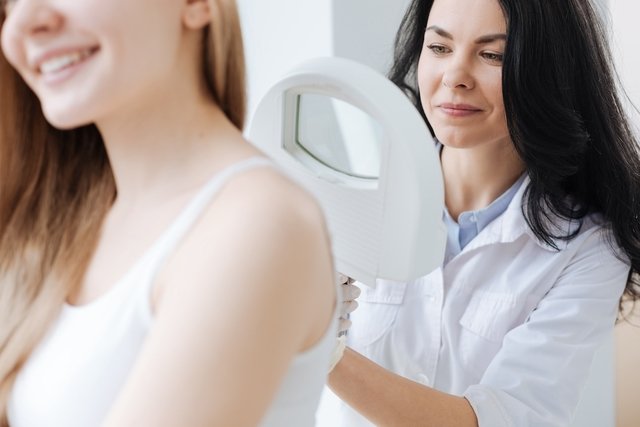Ringworm is an infection caused by the excessive growth of fungi on the skin, nails, scalp, groin and genital region, causing symptoms such as itching, white spots or redness on the skin or changes in the shape or color of the nail, for example.
This type of infection occurs mainly in moist areas of the body, being transmitted by contact with the skin of an infected person, inadequate hygiene, sharing personal objects, such as towels or hairbrushes, or contact with surfaces contaminated with fungi.
The treatment of ringworm is carried out by a dermatologist, and the use of antifungal medications in the form of ointments, tablets, shampoos or medicated nail polish is normally recommended, which varies depending on the type of ringworm.

Ringworm symptoms
The main symptoms of ringworm are:
- Itching in the area;
- Red, scaly lesions on the skin;
- White or dark spots on the skin;
- Genital discharge and itching;
- Thick, detached, whitish or yellowish nails.
The symptoms of ringworm vary according to the affected area of the body, such as the skin, between the toes, scalp, genital region or nails, for example. See other symptoms of skin, foot and nail mycosis.
Generally, the symptoms of ringworm are progressive and are more common in summer, as heat is one of the factors that favors the proliferation of fungi.
It is important to consult a dermatologist whenever symptoms of ringworm appear so that a diagnosis can be made and the most appropriate treatment can be indicated.
How to confirm the diagnosis
The diagnosis of ringworm is made by a dermatologist through evaluation of symptoms, health history and physical examination observing lesions on the skin or nails.
Make an appointment with the dermatologist in the region closest to you:
Taking care of your health has never been easier!
In addition, the doctor can examine skin lesions using a Wood’s lamp, which is equipment that emits UV light and allows you to rule out other health conditions with similar symptoms, such as erythrasma or pityriasis alba, for example. Find out how the Wood’s lamp exam is performed.
To confirm the diagnosis, the doctor can scrape the lesion from the skin or nail, to analyze it under a microscope and identify the type of fungus and, thus, indicate the most appropriate treatment.
Possible causes
Ringworm is caused by fungi that often live normally on the skin or mucous membranes, such as Candida albicans or Malassezia furfurfor example, which can multiply exaggeratedly due to a weakening of the immune system, diabetes or prolonged use of antibiotics.
Additionally, other fungi that can cause ringworm are Trichophyton sp., Microsporum sp., Fusarium sp. or Epidermophyton sp, causing mycoses, such as tinea capitis, tinea corporis, tinea pedis or chilblains, or onychomycosis, for example.
Read too: 10 diseases caused by fungi: symptoms and treatment
How do you catch ringworm
Ringworm can be transmitted in the following ways:
- Direct contact with skin lesions of a person infected with fungi;
- Contact with the skin or hair of infected animals;
- Sharing towels, clothes, shoes, socks, hairbrushes, combs, caps, nail clippers or cuticle spatulas;
- Walking barefoot in public places, such as bathrooms or poolside;
- Wear very tight clothing or underwear made of synthetic material;
- Let the clothes dry on the body after getting wet or sweating a lot;
- Prolonged contact with soil highly infected by fungi.
Furthermore, not properly drying the skin and between the fingers after bathing or swimming in pools, rivers or the sea can encourage the growth of fungi on the skin, as they need warm and humid environments to proliferate. Check out other ways mycosis is transmitted.
Types of ringworm
The main types of ringworm are:
1. Candidiasis
Candidiasis is a type of mycosis caused by fungi of the genus Candida sp., and affect the skin, mainly fold areas, such as the groin, neck, armpits, behind the knee and under the breasts, causing cutaneous candidiasis. Know how to identify the symptoms of cutaneous candidiasis.
Furthermore, this fungus can also affect mucous membranes, such as the mucous membrane of the mouth or throat, causing oral candidiasis, or the genital region and causing vaginal candidiasis or penile candidiasis.
Read too: Candidiasis: what it is, symptoms, causes and treatment
2. Versicolor beeps
Pityriasis versicolor, also known as tinea versicolor, white cloth or beach ringworm, is a type of ringworm caused by the fungus Malassezia furfur.
This type of ringworm mainly affects the skin of the face, trunk, neck and arms, causing white patches, itching and peeling of the skin.
Read too: 9 main causes of skin blemishes (and how to remove them)
3. Onychomycose
Onychomycosis is a type of mycosis that affects the nails, caused by fungi such as Trichophyton rubrum, Microsporum spp., Epidermophyton your spp Candida spp.
This type of mycosis can cause changes in the texture of the nail, increased thickness, yellow, green or white color, or even detachment of the nail. See other symptoms of nail fungus.
4. Frieira
Chilblains, also known as athlete’s foot, is a type of mycosis that develops between the toes and is normally caused by fungi such as Trichophyton red, Trichophyton interdigitale or Epidermophyton floccosum.
This type of ringworm, scientifically called tinea pedis, can cause symptoms such as itching, redness, peeling, cracking and a bad smell, for example.
5. Tinea
There are several types of tinea, which can affect different areas of the body, being caused by fungi belonging to the genus Trichophyton or Microsporum.
Thus, some types of tiena are tinea capitis, which affects the scalp, causing ringworm on the scalp, or tinea corporis, which affects the most superficial layers of the skin.
Furthermore, other types are tinea cruris, which affects the skin of the groin and pubic area, causing groin ringworm, or tinea unguium which affects the nails, causing onychomycosis.
The type of ringworm is identified by the dermatologist through diagnostic tests. Learn more about the main types of ringworm.
How the treatment is carried out
The treatment of ringworm must be carried out under the guidance of a dermatologist and is done with the use of antifungal medicines with the aim of eliminating the fungus that causes the infection and, thus, relieving the symptoms.
The main treatments for ringworm that may be recommended by your doctor are:
1. Ringworm ointments
Ringworm ointments, such as ketoconazole, miconazole or terbinafine, may be recommended by the dermatologist for skin mycoses on the feet, groin, armpits, trunk or neck, for example.
These ointments have local action, causing fewer side effects than tablets, and should be used for the duration of treatment indicated by the doctor, even if the symptoms disappear quickly. See the main ointments for ringworm.
These antifungals can also be found in the form of creams, lotions or sprays to apply to the skin.
Read too: Treatment for skin mycosis: ointments, shampoos and nail polishes
2. Antifungal shampoos
Antifungal shampoos, such as ketoconazole or ciclopirox olamine, are usually indicated for the treatment of ringworm on the scalp or beard.
This type of treatment aims to eliminate the fungus and prevent the transmission of mycosis to other areas of the body or to other people.
3. Medicated nail polish
Medicated nail polish, such as amorolfine, clotrimazole or ciclopirox olamine, is indicated for the treatment of nail fungus and must be applied directly to the affected nail. See all treatment options for nail fungus.
These nail polishes can be used alone or together with oral antifungals, which varies depending on the severity of the infection, and should always be recommended by a dermatologist.
Read too: How to treat skin and nail mycosis
4. Antifungal tablets
Antifungal tablets, such as fluconazole, itraconazole or ketoconazole, are recommended by the dermatologist in cases of mycoses such as candidiasis, chilblains, tinea corporis, tinea cruris or onychomycosis, for example.
This type of treatment should always be advised by a dermatologist, as it can cause side effects such as nausea, abdominal pain or changes in the liver and blood cells.
It is important that ringworm treatment is carried out even if the symptoms disappear, as all the fungi may not have yet been eliminated, and symptoms may reappear or even worsen the disease.
How to prevent
Mycosis prevention occurs through simple measures that prevent fungal proliferation, and it is recommended:
- Dry the skin of the groin, armpits, buttocks, under the breasts and between the fingers well after bathing;
- Change socks every time you wear shoes, and whenever they are damp;
- Wear flip-flops or sandals in public places;
- Avoid wearing very tight clothes;
- Wash your skin well with neutral soap after sports that involve skin-to-skin contact with another person;
- Take your pet to the veterinarian if it has patches of hair or blisters on its skin;
- Avoid touching the skin of people who have fungal infections;
Furthermore, it is recommended to wear cotton clothing that allows the skin to breathe and avoid sharing materials for personal use, such as towels, makeup, hairbrushes and nail pliers, for example.
Read too: 11 home remedies for skin ringworm

Sign up for our newsletter and stay up to date with exclusive news
that can transform your routine!
Warning: Undefined array key "title" in /home/storelat/public_html/wp-content/plugins/link-whisper-premium/templates/frontend/related-posts.php on line 12
Warning: Undefined array key "title_tag" in /home/storelat/public_html/wp-content/plugins/link-whisper-premium/templates/frontend/related-posts.php on line 13



